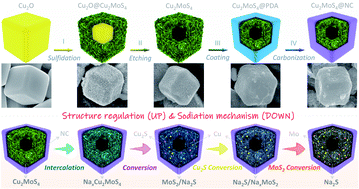Rational design of double-shelled Cu2MoS4@N-doped carbon hierarchical nanoboxes toward fast and stable sodium-ion batteries†
Abstract
Bimetal and/or mixed-metal sulfides have received significant attention for efficient sodium storage due to their high capacity and decent redox activity. However, the poor-rate capability and fast capacity decay dramatically impede their practical application in sodium-ion batteries (SIBs). Herein, a facile multistep template-engaged strategy has been developed to rationally synthesize hierarchical double-shelled nanoboxes with the nitrogen-doped carbon outer shell supported on the nanosheet-constructed Cu2MoS4 inner shell (Cu2MoS4@NC). Benefiting from the unique structure and composition, the Cu2MoS4@NC as a SIB anode delivers excellent electrochemical properties in terms of reversible capacity, rate capability, and cycling stability. Furthermore, electrode kinetics is systematically studied, providing a valuable revelation for understanding its performance evolution. Particularly, the stepwise (re)conversion mechanism involved in the (de)sodiation process for Cu2MoS4@NC has been revealed by in/ex situ measurements, demonstrating that the non-reacted component can act as a temporary buffer/conductor for the reacted one to improve sodium storage. Finally, promising potential in practical application is exhibited, where a designed Cu2MoS4@NC||Na3V2(PO4)2F3/C full cell retains a reversible capacity of 166 mA h g−1 after 1000 cycles at 1.0 A g−1. The research strategy and findings presented herein are expected to boost the development and application of metal sulfide-based anodes in SIBs and beyond.



 Please wait while we load your content...
Please wait while we load your content...